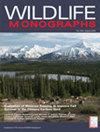下载PDF
{"title":"Influences生境的实际是一种,plant phenology, and人口density on是奥托条目of body condition in northern white-tailed deer人口组成生境的影响植物物候和人口密度的身体条件指数秋天的北欧人口鹿弗吉尼亚影响以南的一种,植物物候学和种群密度对北弗吉尼亚鹿种群秋季身体状况指数的影响","authors":"Anouk Simard, Jean Huot, Sonia De Bellefeuille, Steeve D. C?té","doi":"10.1002/wmon.1010","DOIUrl":null,"url":null,"abstract":"<div>\n \n \n <section>\n \n <p>Body condition has a strong influence on reproduction and survival. Consequently, understanding spatiotemporal variation in body condition may help identify processes that determine life history, and thus demography. The effect of environmental variables on individuals' body condition, although widely documented, is generally achieved by investigating habitat, plant phenology, or density separately, such that cumulative or interactive effects can rarely be considered. We investigated how spatial and annual variation in habitat composition, deer density, and vegetation productivity influenced white-tailed deer (<i>Odocoileus virginianus</i>) body condition during the breeding period. We detailed changes in body condition using several indices, including body mass, peroneus muscle mass, rump fat, kidney fat index, and antler size in >4,000 male and female deer of different ages harvested during September–December, 2002–2006 on Anticosti Island, Québec, Canada. Overall, females and yearlings harvested in fir forests were in poorer condition than those harvested in peatlands or spruce forests, whereas body condition of adult males was greater when open habitats were highly available. High deer density reduced autumn gains in fat, muscle mass, and body mass in males and yearlings, and in fat for females. Surprisingly, density positively affected the size of male antlers. High density at birth favored fat accumulation in adult females, suggesting strong selective pressure that removed low-quality individuals in early age at high deer density. Low Normalized Difference Vegetation Index (NDVI) in spring was associated with delayed but rapid spring green-up, and favored higher body condition in autumn. Reproduction affected most parameters of body condition; lactating females had less mass, fat, and muscle than non-lactating females, whereas mass and fat of males >4 years old steeply declined during the rut. Body mass and fat reserves showed a stronger response to density, habitat, NDVI, and reproduction than muscle mass. Body mass was a good integrating measure of fat and muscle mass, although allocation between muscle growth and energy storage was confounded. Our study highlighted the influence of environmental conditions on individual fat reserves, muscle mass, and body mass in autumn, with potential effects on reproduction and winter survival. Appropriate monitoring of body-condition indices in the fall can track the effect of environmental variables and management practices on animal populations. © 2014 The Wildlife Society</p>\n </section>\n </div>","PeriodicalId":235,"journal":{"name":"Wildlife Monographs","volume":"187 1","pages":"1-28"},"PeriodicalIF":4.3000,"publicationDate":"2014-06-24","publicationTypes":"Journal Article","fieldsOfStudy":null,"isOpenAccess":false,"openAccessPdf":"https://sci-hub-pdf.com/10.1002/wmon.1010","citationCount":"37","resultStr":"{\"title\":\"Influences of habitat composition, plant phenology, and population density on autumn indices of body condition in a northern white-tailed deer population\\n Influencia de la composición del hábitat, de la fenología vegetal y de la densidad poblacional en los Índices de condición corporal otoñal de una población nórdica de ciervos de Virginia\\n Influence de la composition de l'habitat, de la phénologie végétale et de la densité de population sur les indices de condition corporelle automnale d'une population de cerfs de Virginie Nordique\",\"authors\":\"Anouk Simard, Jean Huot, Sonia De Bellefeuille, Steeve D. C?té\",\"doi\":\"10.1002/wmon.1010\",\"DOIUrl\":null,\"url\":null,\"abstract\":\"<div>\\n \\n \\n <section>\\n \\n <p>Body condition has a strong influence on reproduction and survival. Consequently, understanding spatiotemporal variation in body condition may help identify processes that determine life history, and thus demography. The effect of environmental variables on individuals' body condition, although widely documented, is generally achieved by investigating habitat, plant phenology, or density separately, such that cumulative or interactive effects can rarely be considered. We investigated how spatial and annual variation in habitat composition, deer density, and vegetation productivity influenced white-tailed deer (<i>Odocoileus virginianus</i>) body condition during the breeding period. We detailed changes in body condition using several indices, including body mass, peroneus muscle mass, rump fat, kidney fat index, and antler size in >4,000 male and female deer of different ages harvested during September–December, 2002–2006 on Anticosti Island, Québec, Canada. Overall, females and yearlings harvested in fir forests were in poorer condition than those harvested in peatlands or spruce forests, whereas body condition of adult males was greater when open habitats were highly available. High deer density reduced autumn gains in fat, muscle mass, and body mass in males and yearlings, and in fat for females. Surprisingly, density positively affected the size of male antlers. High density at birth favored fat accumulation in adult females, suggesting strong selective pressure that removed low-quality individuals in early age at high deer density. Low Normalized Difference Vegetation Index (NDVI) in spring was associated with delayed but rapid spring green-up, and favored higher body condition in autumn. Reproduction affected most parameters of body condition; lactating females had less mass, fat, and muscle than non-lactating females, whereas mass and fat of males >4 years old steeply declined during the rut. Body mass and fat reserves showed a stronger response to density, habitat, NDVI, and reproduction than muscle mass. Body mass was a good integrating measure of fat and muscle mass, although allocation between muscle growth and energy storage was confounded. Our study highlighted the influence of environmental conditions on individual fat reserves, muscle mass, and body mass in autumn, with potential effects on reproduction and winter survival. Appropriate monitoring of body-condition indices in the fall can track the effect of environmental variables and management practices on animal populations. © 2014 The Wildlife Society</p>\\n </section>\\n </div>\",\"PeriodicalId\":235,\"journal\":{\"name\":\"Wildlife Monographs\",\"volume\":\"187 1\",\"pages\":\"1-28\"},\"PeriodicalIF\":4.3000,\"publicationDate\":\"2014-06-24\",\"publicationTypes\":\"Journal Article\",\"fieldsOfStudy\":null,\"isOpenAccess\":false,\"openAccessPdf\":\"https://sci-hub-pdf.com/10.1002/wmon.1010\",\"citationCount\":\"37\",\"resultStr\":null,\"platform\":\"Semanticscholar\",\"paperid\":null,\"PeriodicalName\":\"Wildlife Monographs\",\"FirstCategoryId\":\"99\",\"ListUrlMain\":\"https://onlinelibrary.wiley.com/doi/10.1002/wmon.1010\",\"RegionNum\":1,\"RegionCategory\":\"生物学\",\"ArticlePicture\":[],\"TitleCN\":null,\"AbstractTextCN\":null,\"PMCID\":null,\"EPubDate\":\"\",\"PubModel\":\"\",\"JCR\":\"Q1\",\"JCRName\":\"ECOLOGY\",\"Score\":null,\"Total\":0}","platform":"Semanticscholar","paperid":null,"PeriodicalName":"Wildlife Monographs","FirstCategoryId":"99","ListUrlMain":"https://onlinelibrary.wiley.com/doi/10.1002/wmon.1010","RegionNum":1,"RegionCategory":"生物学","ArticlePicture":[],"TitleCN":null,"AbstractTextCN":null,"PMCID":null,"EPubDate":"","PubModel":"","JCR":"Q1","JCRName":"ECOLOGY","Score":null,"Total":0}
引用次数: 37
引用
批量引用


